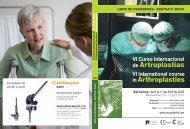cadera / hip - Active Congress.......
cadera / hip - Active Congress.......
cadera / hip - Active Congress.......
Create successful ePaper yourself
Turn your PDF publications into a flip-book with our unique Google optimized e-Paper software.
JUEVES / THURSDAY<br />
222<br />
SOURCES OF ERRORS IN<br />
TOTAL KNEE ARTHROPLASTY:<br />
THE IMPORTANCE OF<br />
CAREFUL, ACCURATE<br />
INTRA-OPERATIVE<br />
MEASUEREMENT<br />
D. Stulberg<br />
Northwestern University Feinberg School<br />
of Medicine - Chicago, Illinois, USA<br />
EVOLUTION OF THE<br />
CRUCIATE RETAINING TKA<br />
V. M Goldberg, M.D<br />
Department of Orthopaedics<br />
Case Western Reserve University<br />
University Hospitals of Cleveland<br />
Cleveland, Ohio, USA<br />
The function of the PCL includes transmission<br />
of load, preventing posterior tibial subluxation<br />
in fl exion, enhanced femoral rollback which<br />
increases flexion, enhanced quadriceps<br />
power and increased effi ciency in stair climbing.<br />
The PCL provides primary and secondary<br />
stability, enhanced proprioception and<br />
reduced the shear stresses at the implant<br />
interface. Additionally if one retains the PCL<br />
the jointline is usually more easily maintained;<br />
kinematics of the total knee replacement is<br />
enhanced, and femoral bone stock may be<br />
preserved. However, if the PCL is retained,<br />
you must have optimum component design<br />
and excellent surgical technique.<br />
Critical in the femoral component design is<br />
an optimal fi t of the femur reconstructing the<br />
anterior-posterior dimensions of the medial<br />
femoral condyle and duplicating the different<br />
radius of curvatures of the lateral and<br />
medial condyle for effective kinematics of<br />
the knee. Tibial articulating geometry also<br />
should support the knee rollback and rotation.<br />
The sagittal plane resection (posterior slope)<br />
of the tibial must also duplicate the patient’s<br />
anatomy. Studies of stair climbing and walking<br />
by Andriacchi, Dorr and Kelman indicate<br />
the PCL-sparing knee replacements provide<br />
an improved kinematic outcome for total knee<br />
arthroplasty. Our own initial experience with<br />
442 consecutive primary knees retaining the<br />
posterior cruciate between August, 1989 and<br />
June, 1994, demonstrated over 90% excellent/good<br />
results with an average range of<br />
motion of 112 degrees. With a minimum<br />
twelve year follow-up there have been 20<br />
revisions. (2 for loosening, 18 for wear/osteolysis).<br />
A newer design to address the<br />
issues of wear, enhance range of motion and<br />
femoral-patellar function has been used since<br />
1995. Our fi rst 104 PCL sparing knees for osteoarthritis<br />
have been followed for 7-9 years.<br />
The average Knee Score is 94.6, Function<br />
score 88.9 and average range of motion of<br />
117 degrees. There is a 100% survival of<br />
these total knee replacements without any<br />
pending revisions. There are still a number<br />
of issues that require solution<br />
These include: range of motion, better materials<br />
for improved wear, enhanced soft<br />
tissue balancing. and component position<br />
and improved rate of recovery of the patient<br />
Issues which have been resolved are fi xation,<br />
instrumentation, alignment, excellent pain<br />
relief and good function. Successful total<br />
knee replacement still depends on patient<br />
selection, implant design and post-operative<br />
rehabilitation.





